
The Douglas F5D Skylancer is a development of the F4D Skyray jet fighter for the United States Navy. Starting out as the F4D-2N, an all-weather version of the Skyray, the design was soon modified to take full advantage of the extra thrust of the Pratt & Whitney J57 eventually fitted to the Skyray instead of the Westinghouse J40 originally planned.
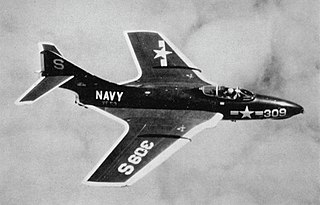
The Grumman F9F/F-9 Cougar is a carrier-based jet-powered fighter aircraft designed and produced by the American aircraft manufacturer Grumman.

The AEG D.I was a biplane fighter of World War I. Three prototypes were ordered, but after the first two were involved in serious crashes, one of which killed flying ace Walter Höhndorf on September 5, 1917, development was cancelled. A triplane version was built as the Dr.I. The second and third prototypes differed little from the first except in detail.
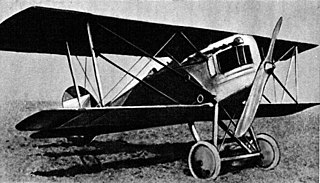
The Aero A.18 was a biplane fighter aircraft built in Czechoslovakia in the 1920s. It was a development of the Ae 02 and Ae 04 fighters Aero had designed during World War I, but also borrowed from the more recent A.11 reconnaissance-bomber design.

The Aero A.32 was a biplane built in Czechoslovakia in the late 1920s for army co-operation duties including reconnaissance and tactical bombing. While the design took the Aero A.11 as its starting point, the aircraft incorporated significant changes to make it suited for its new low-level role.

The Aero A.100 was a biplane light bomber and reconnaissance aircraft built in Czechoslovakia during the 1930s. It was the final step in a design lineage that extended back to the Aero A.11 a decade earlier. A.100s remained in service throughout World War II and for a few years postwar.
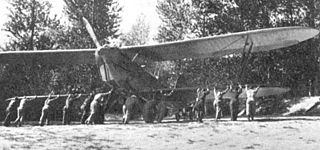
The Aero A.101 was a biplane light bomber and reconnaissance aircraft built in Czechoslovakia during the 1930s.
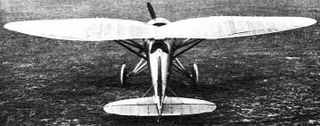
The Aero A.102 was a Czechoslovakian fighter aircraft that flew in prototype form in 1934. It was developed in response to a Czech Air Force requirement of that year, but was passed over in favour of the Avia B.35.

The Aero Ae 02 was the first fighter aircraft to be designed and built in Oshowitz. The Aero aircraft first flew in 1920.

The Aero Ae 04 was a Czechoslovakian biplane fighter aircraft of 1921. A development of the Ae 02, it was no more successful than its predecessor in attracting purchase orders, and it flew only in prototype form. Undaunted by the lack of interest, development continued as the A.18.

The XB-38 Flying Fortress was a single example conversion of a production B-17E Flying Fortress, testing whether the Allison V-1710 V type engine could be substituted for the standard Wright R-1820 radial engine during early World War II.

The Curtiss XP-71 was a 1941 American proposal for an exceptionally large heavy fighter design. It was intended to serve as an extreme-range interceptor and escort fighter. While significant progress was made in the design phase, no prototypes were ever built, and the design was abandoned in 1943.

The Boeing F2B was a biplane fighter aircraft of the United States Navy in the 1920s, familiar to aviation enthusiasts of the era as the craft of the Three Sea Hawks aerobatic flying team, famous for its tied-together formation flying.

The Curtiss F7C Seahawk was a carrier-capable biplane fighter aircraft of the United States Navy Marine Corps in the late 1920s and early 1930s.
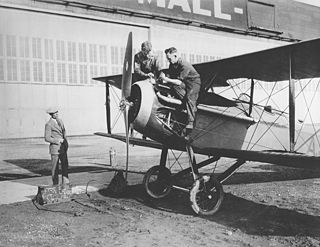
The Vought VE-7 "Bluebird" was an early biplane of the United States. First flying in 1917, it was designed as a two-seat trainer for the United States Army, then adopted by the United States Navy as its first fighter aircraft. In 1922, a VE-7 became the first airplane to take off from an American aircraft carrier.
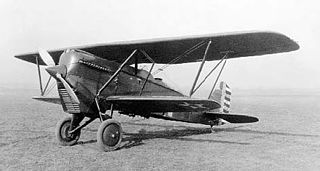
The Boeing XP-7 was a prototype United States biplane fighter of the 1920s.

The Avia BH-22 was a trainer aircraft built in Czechoslovakia in 1925, based on the BH-21 fighter. A smaller engine was used and armament removed. The lighter engine required the wing stagger to be decreased. No significant modifications were made to the airframe structure, reduced weight further increasing the ultimate load factor. Some aeroplanes carried a camera gun. The type saw long service as a special aerobatic trainer and eventually several examples found their way into Czechoslovakia's aero clubs.

The Curtiss XP-22 Hawk was a 1930s American experimental biplane fighter built by Curtiss for evaluation by the United States Army Air Service.

The Levasseur PL.6 C.2, also known as Levasseur VI C.2, was a two-seat fighter aircraft built in France in 1926 in order to meet a 1925 C.2 Service Technique de l'Aéronautique (STAé) specification,. Constructed along the same lines as Levasseur's naval aircraft of the same era, it was a conventional, single-bay biplane with seating for the pilot and tail gunner in separate, open cockpits. Flight testing of the prototype commenced in 1926, and it was exhibited at the Salon de l'Aéronautique at the end of the year.

The Macchi M.71 was an Italian flying boat fighter of the 1930s designed and manufactured by Macchi.




















